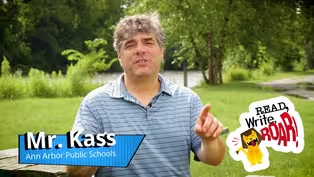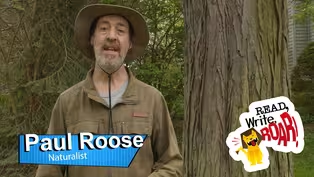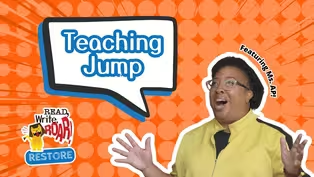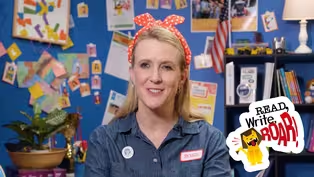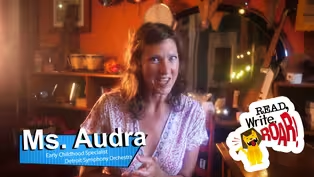Read, Write, ROAR!
Media Literacy & Camera Shots: Telling Stories Through Film | Ms. Kara | Read, Write, ROAR!
Clip: Season 1 Episode 1001 | 4m 14sVideo has Closed Captions
Learn about different camera shots like establishing shots, medium shots, and close-ups.
Ever wondered how filmmakers tell stories with their cameras? In this video, learn about different camera shots like establishing shots, medium shots, and close-ups. We’ll show you how filmmakers use these techniques to create compelling digital stories, all while exploring a garden and talking about the importance of soil!
Problems playing video? | Closed Captioning Feedback
Problems playing video? | Closed Captioning Feedback
Read, Write, ROAR! is a local public television program presented by Detroit PBS
Read, Write, ROAR!
Media Literacy & Camera Shots: Telling Stories Through Film | Ms. Kara | Read, Write, ROAR!
Clip: Season 1 Episode 1001 | 4m 14sVideo has Closed Captions
Ever wondered how filmmakers tell stories with their cameras? In this video, learn about different camera shots like establishing shots, medium shots, and close-ups. We’ll show you how filmmakers use these techniques to create compelling digital stories, all while exploring a garden and talking about the importance of soil!
Problems playing video? | Closed Captioning Feedback
How to Watch Read, Write, ROAR!
Read, Write, ROAR! is available to stream on pbs.org and the free PBS App, available on iPhone, Apple TV, Android TV, Android smartphones, Amazon Fire TV, Amazon Fire Tablet, Roku, Samsung Smart TV, and Vizio.
Providing Support for PBS.org
Learn Moreabout PBS online sponsorshipI think you.
Oh, this is a cool shot.
What if I zoom in?
Well, hello, scholars.
I am media literacy, Maddie.
And today I'm using this piece of paper to create a frame to show what I would see through my camera.
Video cameras can tell digital stories with the framing the camera operator uses.
And that's what we're going to be talking about today on Read Right Raw.
Let's go find this care.
Hi everyone.
I miss Cara, I've been learning about why high quality soil is necessary to grow fresh fruits and vegetables by watching this video from Destination Michigan.
When you watch shows on a screen, it's helpful to understand film language, which is different from language written with words.
Film language is told through different camera shots and angles.
If you know this language, you'll understand why media creators make certain production decisions about the media they produce.
Let's see how this video was created.
This is an establishing shot at Willow Run Acres.
This shot tells us the location or setting.
I have an idea.
Let's record some shots of Maddy in the garden.
This shot is an establishing shot of Maddy.
It sets the scene and tells us she is in her garden.
Now it's your turn to practice in establishing shot.
Grab some paper and a pencil.
Fold your paper in thirds.
Like this.
In this column, draw an establishing shot or a shot that sets a scene of a house and some trees.
Great job everyone.
This next shot is a medium shot.
This is used during an interview.
In this medium shot, you can see the top of Mr. Collins.
Head down to his chest.
Do you also notice the writing or title here?
This is called the Lower third, and it's used to identify who the person is and their relationship to the topic of the video.
This is the medium shot of Maddy.
Do you notice that it's closer than the establishing shot of the garden setting we saw earlier?
We can see a lot more detail.
Do you notice there's a lower third to identify who she is and what she's doing?
Now take your paper and pencil and draw a medium shot.
Underneath.
It's okay if you draw a stick figure like I did.
The last shot type is a closeup.
This framing is important when you want to show detail of an object or emotion on a person's face.
Here's a close up from the video we've been watching.
This is a closeup of Maddy boom.
I wonder what she's found.
That's so interesting.
And now get your paper and pencil one last time.
Draw a closeup of a plant growing near the soil.
We've learned so much about different camera distances and the use of titles today.
Here's one final activity for you to try.
Can you identify the film language that matches what is shown in each image?
If you guessed closeup, medium shot, establishing shot, and lower third, you are right.
Today we learned about several shots used in film language to tell stories in establishing shot, medium shot and close up.
We also learned about how a lower third, which is writing on a screen, is used to identify someone in an interview.
Film language is spoken with cameras to convey a message.
If you ever get a chance to speak film language from behind a camera, what would you say to make your message clear?
Michigan Farmer: A First-Person Narrative | Jeff Kass | Read, Write, ROAR!
Video has Closed Captions
Clip: S1 Ep1001 | 6m 6s | What’s it like to be a farmer in Michigan? (6m 6s)
Nature Journaling 101: Birdwatching with a Naturalist | Paul Roose | Read, Write, ROAR!
Video has Closed Captions
Clip: S1 Ep1001 | 4m 22s | Join naturalist Paul Roose as he takes you birdwatching and shows you how to start your own nature j (4m 22s)
Read, Write, ROAR! Restore - Teaching Jump
Video has Closed Captions
Clip: S1 Ep1001 | 1m 54s | Powerful Pencil Jumps: Jump into action with Ms. AP in this 2-minute movement snack. (1m 54s)
Rosie the Riveter - Writing Using Multiple Sources| Mrs. DeFauw | Read, Write, ROAR!
Video has Closed Captions
Clip: S1 Ep1001 | 5m 37s | Watch as Mrs. DeFauw models how to take notes and write summaries to help remember key ideas. (5m 37s)
Symphony Soundscape | Make Music with Ms. Audra | Read, Write, ROAR!
Video has Closed Captions
Clip: S1 Ep1001 | 1m 57s | Become the conductor of your very own symphony! (1m 57s)
Providing Support for PBS.org
Learn Moreabout PBS online sponsorship

- Home and How To

Hit the road in a classic car for a tour through Great Britain with two antiques experts.












Support for PBS provided by:
Read, Write, ROAR! is a local public television program presented by Detroit PBS
